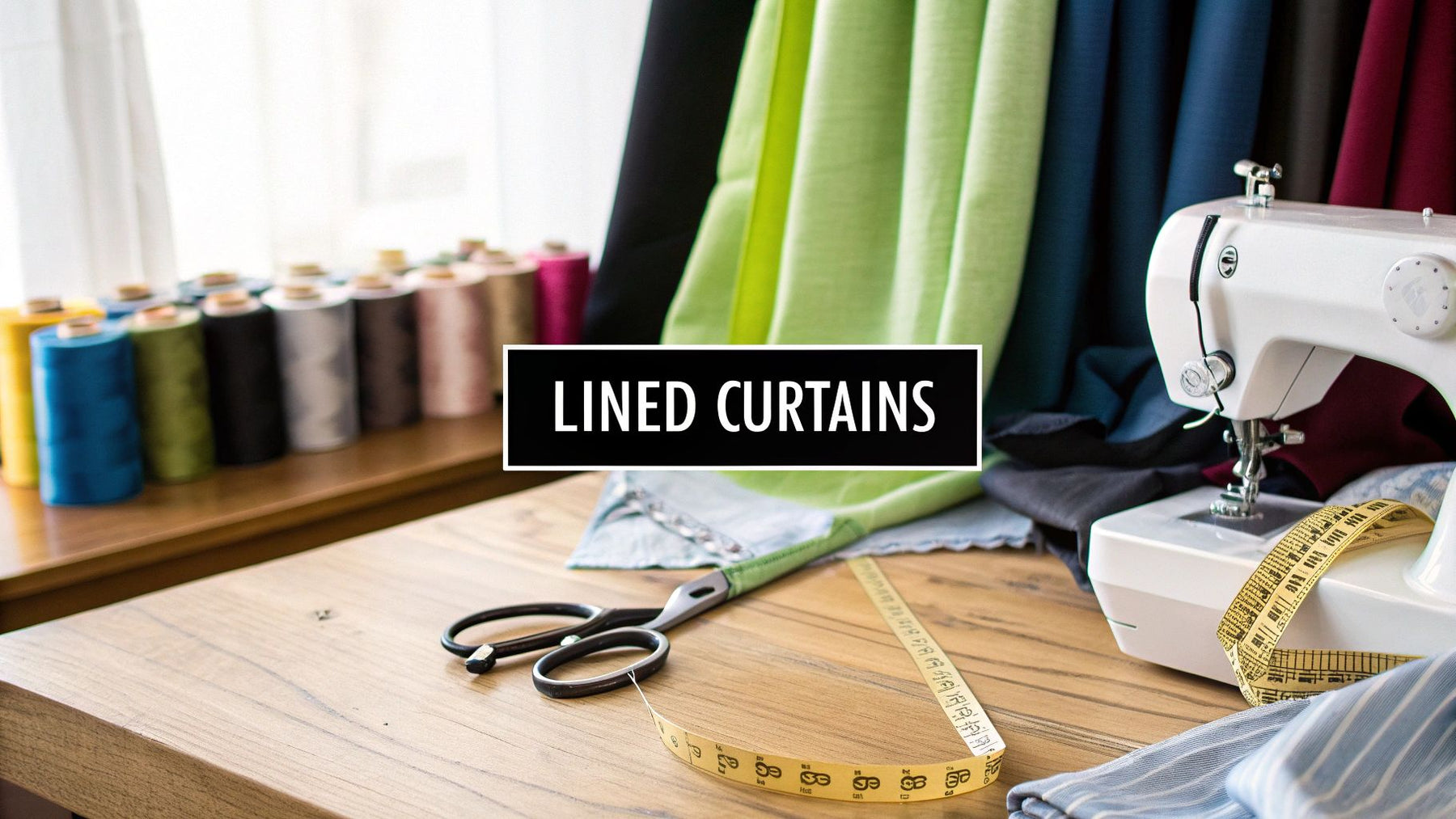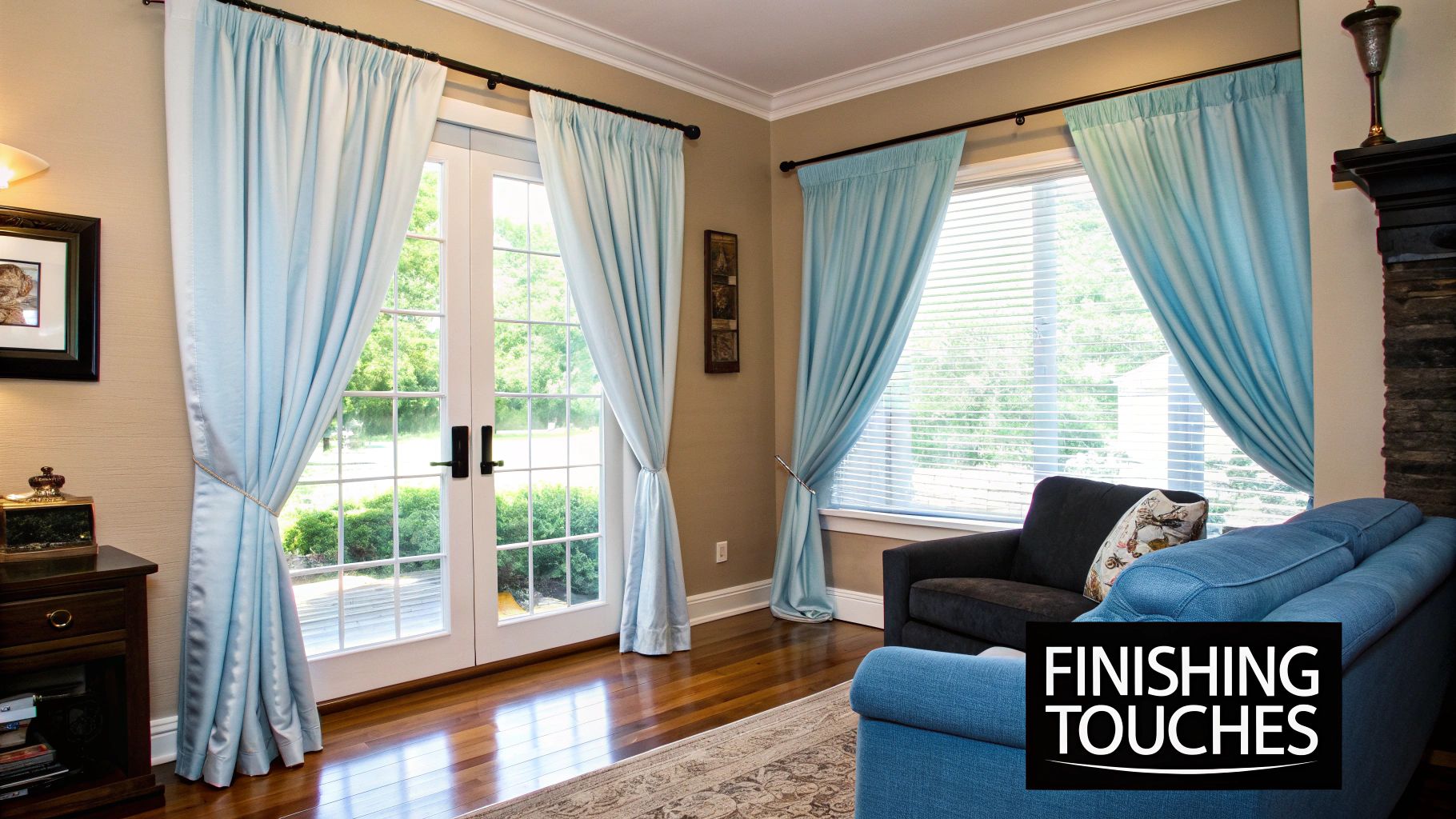
How to Make Lined Curtains: A Step-by-Step Guide
Learning how to make lined curtains is a DIY project that pays off big time. It gives you the power to create custom window treatments that perfectly fit your windows and your style—something you just can't get off the shelf. Using a simple "bagging" method, you can achieve a clean, professional finish that's surprisingly easy.
This guide will walk you through the entire process, from measuring your windows to the final stitch. With a little patience and the right technique, you'll transform any room with beautiful, functional curtains you made yourself.
Table of Contents
- Why Lined Curtains Are a Game-Changer
- Gathering Your Essential Tools & Materials
- Getting Your Measurements and Cuts Just Right
- Assembling Your Curtains with the Bagging Method
- Adding the Final Touches for a Custom Look
- Frequently Asked Questions
Why Lined Curtains Are a Game-Changer
Before you start sewing, it’s worth understanding why adding a lining is so important. It isn't just an extra step; it's what elevates a piece of fabric into high-impact, functional decor. A lining completely changes how your curtains look, hang, and perform.
Right away, you'll see a huge difference in light control. A single layer of fabric might dim a room, but a blackout or dimout lining gives you the power to make it truly dark—perfect for bedrooms or a media room. A lining also provides a major privacy boost, keeping your home a private sanctuary.
Choosing the right materials is key. If you're not sure where to start, check out our in-depth guide on curtain cloth types to help you make the best choice.
More Than Just Good Looks: The Practical Perks
The benefits go beyond aesthetics. Lined curtains are fantastic insulators, trapping heat in during winter and blocking it out in summer. This thermal barrier can lead to real energy savings over time.
It’s no surprise that the global market for curtains and blinds is expected to hit USD 57.6 billion by 2034, largely driven by the demand for energy-efficient solutions. As consumers seek more sustainable living, functional decor like insulated curtains is becoming essential. You can discover more insights about this growing market and its trends.
Insider Tip: A good lining also acts as a shield for your main curtain fabric. It protects it from sun damage and fading, which means the beautiful pattern you fell in love with will stay vibrant for years to come.
Ultimately, making your own lined curtains is about getting that custom, high-end look without the designer price tag. You control the fullness, length, and quality, resulting in window treatments that hang beautifully and work perfectly.
Gathering Your Essential Tools & Materials

A great sewing project starts before the first stitch. Getting your tools and materials organized first is the secret to a smooth, enjoyable process. When you're making lined curtains, a little prep goes a long way.
Core Sewing & Cutting Tools
Your sewing machine is the star, but its supporting cast is just as crucial. Drapery fabric can be heavy, so you need a setup that can handle it.
- Sewing Machine: A standard machine will work perfectly. Just ensure it's tuned up and ready.
- Needles: Use a size 90/14 or 100/16 universal needle. These are strong enough for multiple layers.
- Fabric Scissors or Rotary Cutter: Sharp, dedicated fabric scissors are non-negotiable. A rotary cutter and self-healing mat provide even straighter cuts.
- Quilter's Ruler: This transparent, gridded ruler is a game-changer for ensuring square corners and accurate measurements.
- Measuring Tape: A soft, flexible measuring tape is essential for accurate window and fabric measurements.
Choosing Your Fabric & Lining
The main fabric gives your curtains their personality; the lining gives them their purpose. The trick is to pick fabrics that complement each other in weight and care needs. Before buying, you must know how much you need. To avoid costly mistakes, learn how to calculate fabric yardage correctly.
This table breaks down classic pairings to help you decide.
| Curtain Fabric | Lining Fabric | Primary Benefit | Best For |
|---|---|---|---|
| Cotton or Linen | Standard Cotton | Structure & Drape | Living rooms, kitchens, casual spaces |
| Silk or Faux Silk | Interlining & Cotton | Volume & UV Protection | Formal dining rooms, formal living rooms |
| Velvet | Thermal | Insulation & Drape | Bedrooms, drafty rooms, home theaters |
| Polyester Blend | Blackout | Light Blockage | Bedrooms, media rooms, nurseries |
Pro Tip: Always pre-wash and iron both your main fabric and lining before cutting. This simple step prevents heartbreaking shrinkage after your hard work is done.
Finally, don't forget the hardware. The weight of your finished curtains dictates the support you need. A heavy velvet panel with blackout lining requires a sturdy rod. Our guide on curtain rods for heavy curtains is a great resource.
Getting Your Measurements and Cuts Just Right

When making your own curtains, precision is everything. Getting your measurements right from the start is what separates a professional look from a homemade one.
The secret to incredible-looking curtains isn't just measuring the window itself; it's about how you frame it. Install your rod at least 4-6 inches above the window frame and extend it 6-10 inches on each side. This trick makes ceilings feel taller and windows grander.
For a more detailed walkthrough, we have a comprehensive guide on how to measure your windows for curtains right here on our blog.
Figuring Out How Much Fabric You Need
Once your rod is up, lock in your final measurements. The formulas are simple, but my best advice is to measure twice and cut once.
For Curtain Length: Measure from the bottom of your rod to your desired endpoint (float, kiss, or puddle).
- Bottom Hem: Add 8 inches for a double-folded 4-inch hem.
- Top Header/Rod Pocket: Add 6 inches for a double-folded 3-inch pocket.
- Total Length to Add: Add a total of 14 inches to your desired finished length.
For Curtain Width: Measure the rod's width (excluding finials). For a full, luxurious look, your total panel width should be 1.5 to 2 times the rod width.
Multiply your rod width by 1.5 or 2, then divide by two to get the ideal width for each panel.
Crucial Tip: Add an extra 4 inches to the width of each panel. This accounts for the 1-inch double-folded side hems, which create crisp, professional edges.
The Art of the Straight Cut
Cutting long pieces of fabric perfectly straight can feel intimidating. Don't eyeball it.
Lay your washed and ironed fabric on a large, flat surface—the floor often works best. For the most accurate results, use a quilter's ruler and a rotary cutter. A perfect cut is the foundation of a beautiful curtain.
Assembling Your Curtains with the Bagging Method
This is where your fabric pieces become beautiful, functional curtains. We'll use the "bagging method," a professional technique that creates perfectly enclosed side seams for an incredibly clean finish.
Think of it as sewing a giant pillowcase and turning it right-side out. This hides all raw edges inside, giving your curtains a polished, high-end look from every angle.
Joining the Main Fabric and Lining
With your fabric cut and pressed, it’s time to join the layers. Lay your main fabric on a large, flat surface with the right side facing up.
Now, place your lining fabric on top with its right side facing down. The two "good" sides of your fabrics should be touching. Carefully align all edges and pin them securely to prevent shifting.
This visual guide breaks down the core steps of the process.

As you can see, it's a sequence of aligning, sewing, and turning. This is the foundation for achieving those crisp, professional seams.
Sewing the Long Side Seams
Head to the sewing machine. Starting at a top corner, sew a straight stitch down the entire length of one long side using a 1/2-inch seam allowance. Guide the fabric steadily; don't pull or stretch it.
Repeat on the other long side. You should now have a long fabric tube open at the top and bottom.
Insider Tip: Don't skip this! Press your seams open. Lay the panel on your ironing board, open the seam allowances you just sewed, and press them flat. This step makes turning the panel easier and gives you sharper edges.
Turning and Finishing the Panel
It's time for the big reveal. Reach inside the fabric tube, grab the opposite corner, and gently pull the fabric through to turn the panel right-side out.
Once turned, use a point turner or a chopstick to gently poke out the corners so they are square.
Lay the panel flat with the lining side up. Adjust the fabric so the side seams are neat and the main fabric wraps around to create a small, even border on the back—about one inch on each side is standard. Press the entire panel thoroughly. This ensures the lining will never peek out from the front.
Finally, create the hems:
- Bottom Hem: Fold the bottom raw edges up by 4 inches, press, then fold another 4 inches for a heavy, double-folded hem. Stitch this closed near the top fold.
- Top Header: Repeat at the top with a 3-inch double fold to create the rod pocket. Stitch along the bottom edge of this fold to create the channel for your curtain rod.
Adding the Final Touches for a Custom Look

These finishing steps take your curtains from "homemade" to "custom-made." They are what give your project a polished, high-end appearance.
After sewing, give your new curtains a final, meticulous press. Use a hot iron with plenty of steam to set every seam and flatten the hems. This one step makes a massive difference in how the fabric drapes.
Training Your Curtains to Hang Perfectly
Once pressed, you can "train" your curtains to hang in elegant, uniform folds. This professional trick ensures they look just as good open as they do closed.
Here’s the method:
- Hang your new curtain panels on the rod.
- Arrange the fabric into neat accordion-style pleats from top to bottom.
- Loosely tie the pleated panel in three places (top, middle, and bottom) using soft fabric strips.
- Leave them tied for 48-72 hours. This helps the fabric develop a "memory," so it will naturally fall back into graceful folds.
This bit of patience prevents a puffy, shapeless look and gives your curtains an immediate, professionally installed feel.
Key Takeaway: Don't underestimate the power of a final press and training your curtains. These two steps are the secrets to achieving a truly custom, high-end drape that elevates your entire room.
Selecting the Right Hardware
The hardware you choose is the jewelry for your window treatments. The rod, rings, and finials should complement both your fabric and your room's decor. A heavy velvet curtain needs a substantial rod, while lightweight linen looks best on a more delicate one.
It’s also interesting to see the technology that goes into these materials. The global market for curtain linings and interlinings is projected to hit USD 2.5 billion by 2025, according to a report by Global Market Insights. This growth is driven by demand for better light-blocking, insulation, and durability, showing how important your lining choice is.
Ultimately, taking the time to press, train, and properly hang your curtains on the right hardware completes the process and showcases all your hard work.
Frequently Asked Questions
Even with a detailed guide, a few questions often pop up. Let's tackle the most common hurdles to ensure your project is a success.
Can I make lined curtains without a sewing machine?
The short answer is yes, but it requires significant patience. While you can hand-sew the curtains, achieving long, straight seams is challenging. For strength and a professional finish, a sewing machine is highly recommended. Iron-on hem tape is not strong enough for the long side seams and will likely fail over time due to the fabric's weight.
What is the best thread to use for lined curtains?
An all-purpose polyester thread is the gold standard for most drapery projects. It is strong, has enough give to prevent puckering, and comes in a vast range of colors. Match the thread to your main curtain fabric. If your lining is a different color, use a matching thread in the bobbin for stitches that are virtually invisible on both sides.
Why are my curtain seams puckering?
Puckered seams are a common sewing frustration, but they are usually fixable. The cause is typically one of three things:
- Incorrect Tension: Your machine's upper thread tension might be too tight. Try loosening it slightly and test on a scrap of fabric.
- Dull Needle: A dull needle drags and pulls at the fabric. Use a sharp, new needle appropriate for your fabric's weight, like a 90/14 universal needle.
- Fabric Handling: Avoid pushing or pulling the fabric through the machine. Let the machine's feed dogs do the work while you simply guide the material.
Expert Tip: Pressing your seams with a hot, steamy iron as you go is the single best way to prevent and fix puckering. It helps the threads relax and sets your stitches beautifully flat.
If you want to brush up on your skills before you start, there are tons of fantastic free sewing lessons online that can help build your confidence.
Ready to find the perfect fabric and hardware for your custom curtains? Explore the beautiful and durable home decor collections at Joey'z Shopping and bring your vision to life. https://joeyzshopping.com
